

Impress Guide
Chapter
1
Introducing Impress
This document is Copyright © 2005–2011 by its contributors as listed below. You may distribute it and/or modify it under the terms of either the GNU General Public License (http://www.gnu.org/licenses/gpl.html), version 3 or later, or the Creative Commons Attribution License (http://creativecommons.org/licenses/by/3.0/), version 3.0 or later.
All trademarks within this guide belong to their legitimate owners.
Contributors
Michele
Zarri T. Elliot Turner Jean Hollis Weber
Chad D. Lines Low Song
Chuan Muhammad Sufyan Zainalabidin
Jaimon Jacob
Feedback
Please
direct any comments or suggestions about this document
to:
documentation@global.libreoffice.org
Acknowledgments
This chapter is based on Chapter 1 of the OpenOffice.org 3.3 Impress Guide. The contributors to that chapter are:
Michele
Zarri Jean Hollis Weber Dan Lewis
Agnes Belzunce Peter
Hillier-Brook Gary Schnabl
Claire Wood Rachel Kartch Hazel
Russman
Linda Worthington
Tim Kampa, Charles Fannan, and Dana Oliver, students in the Technical and Professional Writing Program at San Francisco State University, wrote a previous version of this document for OpenOffice.org 1.1 (copyright Tim Kampa).
Publication date and software version
Published 31 July 2011. Based on LibreOffice 3.3.3.
Some keystrokes and menu items are different on a Mac from those used in Windows and Linux. The table below gives some common substitutions for the instructions in this chapter. For a more detailed list, see the application Help.
|
Windows/Linux |
Mac equivalent |
Effect |
|
Tools > Options menu selection |
LibreOffice > Preferences |
Access setup options |
|
Right-click |
Control+click |
Open context menu |
|
Ctrl (Control) |
z (Command) |
Used with other keys |
|
F11 |
z+T |
Open Styles and Formatting window |
Contents
Impress is LibreOffice’s slide show (presentations) program. You can create slides that contain many different elements, including text, bulleted and numbered lists, tables, charts, clip art, and a wide range of graphic objects. Impress also includes a spelling checker, a thesaurus, prepackaged text styles, and attractive background styles.
This chapter introduces the Impress user interface and describes how to create a simple slide show using the Presentation Wizard.
The rest of this guide illustrates many other features available in Impress that can be used to create more sophisticated slide shows.
|
Note |
Drawings are created in the same way with Impress as they are with Draw. Refer to the Draw Guide for details on how to use the drawing facilities. |
You can start Impress in several ways:
If no component of LibreOffice is open, from the Start Center: click on the Presentation icon.
From the system menu or the LibreOffice Quickstarter. Details vary with your operating system; see Chapter 1 in the Getting Started guide if you need more information.
From any open component of LibreOffice: click the triangle to the right of the New icon on the main toolbar and select Presentation from the drop-down menu, or choose File > New > Presentation from the menu bar.
When you start Impress for the first time, the Presentation Wizard is shown. For detailed instructions about how to use the wizard, see “Creating a new presentation” on page 12.
If you prefer not to use the wizard in future, you can select Do not show this wizard again.
Click Create to open the main Impress window.
The main Impress window (Figure 1) has three parts: the Slides pane, the Workspace, and the Tasks pane. Additionally, several toolbars can be displayed or hidden during the creation of a presentation.
|
Tip |
You can remove the Slides pane or the Tasks pane from view by clicking the X in the upper right corner of each pane. You can also show or hide these panes using View > Slide Pane or View > Task Pane or by clicking the Hide/Show marker in the middle of the vertical separator line (circled in illustration). By hiding these panes, you can maximize the Workspace area. |
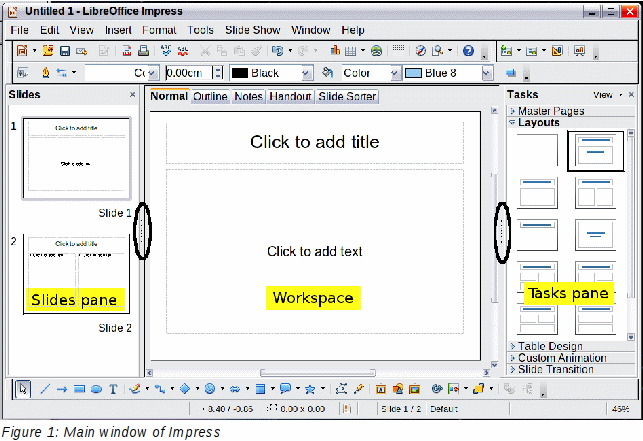
The Slides pane contains thumbnail pictures of the slides in your presentation, in the order they will be shown—unless you change the slide show order, as described in Chapter 9, Slide Shows. Clicking a slide in this pane selects it and places it in the Workspace. When a slide is in the Workspace, you can change it in any way you like.
Several additional operations can be performed on one or more slides simultaneously in the Slides pane:
Add new slides to the presentation.
Mark a slide as hidden so that it will not be shown as part of the presentation.
Delete a slide from the presentation if it is no longer needed.
Rename a slide.
Duplicate a slide (copy and paste) or move it to a different position in the presentation (cut and paste).
It is also possible to perform the following operations, although there are more efficient methods than using the Slides pane, as you will see later in this chapter:
Change the slide transition following the selected slide or after each slide in a group of slides.
Change the sequence of slides in the presentation.
Change the slide design.
Change slide layout for a group of slides simultaneously.
The Tasks pane has five sections: To expand the section you wish to use, click on the right-pointing triangle to the left of the caption. Only one section at a time can be expanded.
Master Pages
Here you define the page style for your presentation. Impress contains prepackaged Master Pages (slide masters). One of them—Default—is blank, and the rest have a background and styled text.
|
Tip |
Press F11 to open the Styles and Formatting window, where you can modify the styles used in any slide master to suit your purposes. This can be done at any time. See Chapter 2 for more information. |
Layouts
The prepackaged layouts are shown here. You can choose the one you want and use it as it is, or you can modify it to meet your own requirements. However, it is not possible to save custom layouts.
Table Design
The standard table styles are provided in this area. You can further modify the appearance of a table with the options to show or hide specific rows and columns, or to apply a banded appearance to the rows and columns. Refer to Chapter 3, Adding and Formatting Text, for details on how to work with tables.
Custom Animation
A variety of animations can be used to emphasize or enhance different elements of each slide. The Custom Animation section provides an easy way to add, change, or remove animations. For additional information, see Chapter 9, Slide Shows, for an overview of how to add and customize animations.
Slide Transition
The Slide Transition section provides access to a number of slide transition options. The default is set to No Transition, in which the following slide simply replaces the existing one. Many additional transitions are available, however. You can also specify the transition speed (slow, medium, fast), choose between an automatic or manual transition, and choose how long the selected slide should be shown (automatic transition only).
The Workspace (normally in the center) has five tabs, also called View buttons.

The Workspace below the View buttons changes depending on the chosen view. The workspace views are described in detail on page 8.
Many toolbars can be used during slide creation; they can be displayed or hidden by clicking View > Toolbars and selecting from the menu.
You can also select the icons that you wish to appear on each toolbar. For more information, refer to Chapter 11, Setting Up and Customizing Impress.
Many of the toolbars in Impress are similar to the toolbars in Draw. Refer to the Draw Guide for details on the functions available and how to use them.
The status bar, located at the bottom of the Impress window, contains information that you may find useful when working on a presentation.


From left to right, you will find:
A general information area, which changes depending on the selection. For example:
Text area—”TextEdit: Paragraph x, Row y, Column z”
Charts, spreadsheets—”Embedded object (OLE) ‘ObjectName’ selected”
Graphics—”Bitmap with transparency selected”
The position of the cursor or of the top left corner of the selection measured from the top left corner of the slide, followed by the width and height of the selection or of the text box where the cursor is located.
A modified flag, showing a star when the file needs saving.
A flag indicating whether the document is digitally signed.
The slide number currently displayed in the workspace, and the total number of slides in the presentation.
The slide master or page style associated with the slide, handout, or notes page currently in the Workspace.
The zoom slider and zoom level (percent) of the Workspace.
|
Note |
The sizes are given in the current measurement unit (not to be confused with the ruler units). This unit is defined in Tools > Options > LibreOffice Draw > General, where you can also change the scale of the page. Another way to change the scale is to double-click on the number shown in the status bar. |
You can hide the information in the Status Bar by selecting View > Status Bar from the main menu.
The
Navigator displays all objects contained in a document. It provides
another convenient way to move around a document and find items in
it. To display the Navigator, click its icon
![]() on the Standard toolbar, or choose View
> Navigator on the menu bar, or press
Ctrl+Shift+F5.
on the Standard toolbar, or choose View
> Navigator on the menu bar, or press
Ctrl+Shift+F5.
The Navigator is more useful if you give your slides and objects (pictures, spreadsheets, and so on) meaningful names, instead of leaving them as the default “Object 1” and “Shape 1” shown in the example below.
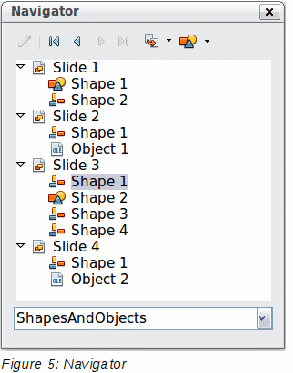
Each of the workspace views is designed to ease the completion of certain tasks; it is therefore useful to familiarize yourself with them in order to quickly accomplish those tasks.
Normal view is the main view for creating individual slides. Use this view to format and design slides and to add text, graphics, and animation effects.
To place a slide in the slide design area (Workspace) of the Normal view (Figure 1), either click the slide thumbnail in the Slides pane or double-click it in the Navigator (page 8).
Outline view contains all of the slides of the presentation in their numbered sequence. It shows topic titles, bulleted lists, and numbered lists for each slide in outline format. Only the text contained in the default text boxes in each slide is shown, so if your slide includes other text boxes or drawing objects, the text in these objects is not displayed. Slide names are not included.

Use Outline view for:
Making changes in the text of a slide:
Add or delete text in a slide just as in the Normal view.
Move the paragraphs of text in the selected slide up or down by using the up and down arrow buttons (Move Up or Move Down) on the Text Formatting toolbar.
Change the outline level for any of the paragraphs in a slide using the left and right arrow buttons (Promote or Demote).
Simultaneously move a paragraph and change its outline level using a combination of these four arrow buttons.
Comparing the slides with your outline (if you have prepared one in advance). If you notice from your outline that another slide is needed, you can create it directly in the Outline view, or you can return to the Normal view to create it.
Use the Notes view (Figure 7) to add notes to a slide. These notes are not seen when the presentation is shown.
Click the Notes tab in the Workspace.
Select the slide to which you want to add notes.
Click the slide in the Slide pane, or
Double-click the slide’s name in the Navigator.
In the text box below the slide, click on the words Click to add notes and begin typing.
You can resize the Notes text box using the green resizing handles and move it by placing the pointer on the border, then clicking and dragging. To make changes in the text style, press the F11 key to open the Styles and Formatting window.
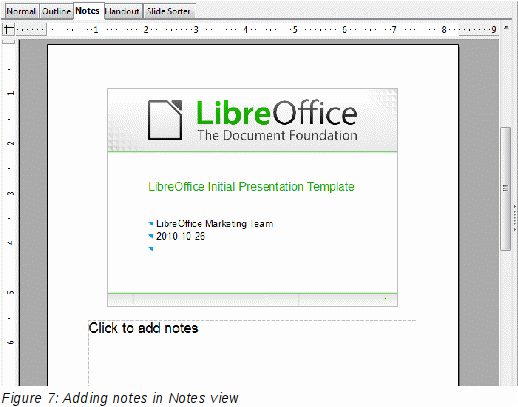
Handout view is for setting up the layout for a printed handout. Click the Handout tab in the workspace, then choose Layouts in the tasks pane. You can then choose to print 1, 2, 3, 4, 6, or 9 slides per page.
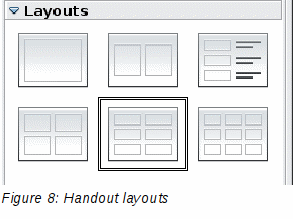
Use this view also to customize the information printed on the handout. Refer to Chapter 10 of this book for instructions on printing slides, handouts, and notes.
The Slide Sorter view contains all of the slide thumbnails. Use this view to work with a group of slides or with only one slide.
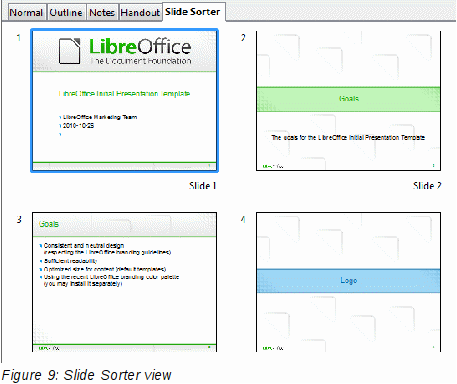
To change the number of slides per row:
Check View > Toolbars > Slide View to show or hide the Slide view toolbar.

Adjust the number of slides (up to a maximum of 15).
Moving a slide using Slide Sorter
To move a slide in a presentation using the Slide Sorter:
Click the slide. A thick border is drawn around it.
Drag and drop it to the location you want.
As you move the slide, a black vertical line appears to one side of the slide.
Drag the slide until this black vertical line is located where you want the slide to be moved.
Selecting and moving groups of slides
To select a group of slides, use one of these methods:
Use the Control (Ctrl) key: Click on the first slide and, while pressing Control, select the other desired slides.
Use the Shift key: Click on the first slide, and while pressing the Shift key, select the final slide in the group. This selects all of the other slides between the first and the last.
Use the mouse: Click slightly to the left of the first slide to be selected. Hold down the left mouse button and drag the mouse pointer to a spot slightly to the right of the last slide to be included. (You can also do this right to left.) A dashed outline of a rectangle forms as you drag the pointer through the slide thumbnails and a thick border is drawn around the selected slides. Make sure the rectangle includes all the slides you want to select.
To move a group of slides:
Select the group.
Drag and drop the group to their new location. A vertical black line appears to show you where the group of slides will go.
You can work with slides in the Slide Sorter view just as you can in the Slide pane.
To make changes, right-click a slide and chose any of the following options from the pop-up menu:
New Slide: Adds a new slide after the selected slide.
Delete Slide: Delete the selected slide
Rename Slide: Allows you to rename the selected slide
Slide Layout: Allows you to change the layout of the selected slide
Slide Transition: Allows you to change the transition of the selected slide
Hide Slide: Hidden slides are not shown in the slide show
Cut: Removes the selected slide and saves it to the clipboard
Copy: Copies the selected slide to the clipboard without removing it
Paste: Inserts a slide from the clipboard. This option will also allow you to specify whether you want to paste the copied slide Before or After the selected slide
Right-click on a thumbnail in the Slides pane or the Slide Sorter and choose Rename Slide from the pop-up menu. In the Name field, delete the old name of the slide and type the new name. Click OK.
This section shows you how to set up a new presentation using the Presentation Wizard.
|
Tip |
The first thing to do is decide on the purpose of the presentation and plan the presentation. Although you can make changes as you go, having an idea of who the audience will be, the structure, the content, and how the presentation will be delivered, will save you a lot of time from the start. |
When you start Impress, the Presentation Wizard appears.
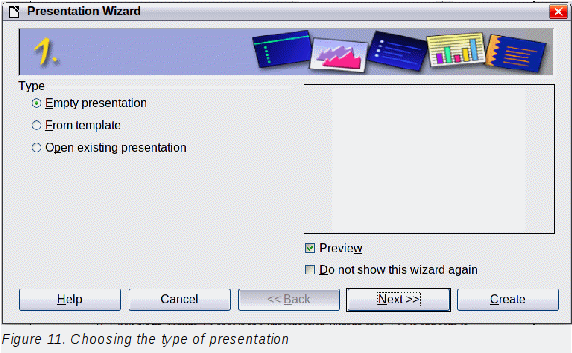
|
Tip |
If you do not want the wizard to start every time you start Impress, select the Do not show this wizard again option. You can enable the wizard again later under Tools > Options > LibreOffice Impress > General > Wizard, and select the Start with wizard option. Leave the Preview option selected, so templates, slide designs, and slide transitions appear in the preview box as you choose them. |
Under Type, choose one of the options:
Empty presentation creates a blank presentation.
From template uses a template design already created as the basis for a new presentation. The wizard changes to show a list of available templates. Choose the template you want. More details can be found in Chapter 2.
Open existing presentation continues work on a previously created presentation. The wizard changes to show a list of existing presentations. Choose the one you want.
Click Next. Figure 12 shows the Presentation Wizard step 2 as it appears if you selected Empty presentation at step 1. If you selected From template, an example slide is shown in the Preview box.
Choose a design under Select a slide design. The slide design section gives you two main choices: Presentation Backgrounds and Presentations. Each one has a list of choices for slide designs. If you want to use one of these other than <Original>, click it to select it.
The types of Presentation Backgrounds are shown in Figure 12. When you click an item, a preview of the slide design appears in the Preview window. <Original> is an empty background.
Impress contains three choices under Presentations:
<Original> is for a blank presentation slide design.
Both Introducing a New Product and Recommendation of a Strategy have their own prepackaged slide designs. Each design appears in the Preview window when its name is clicked.
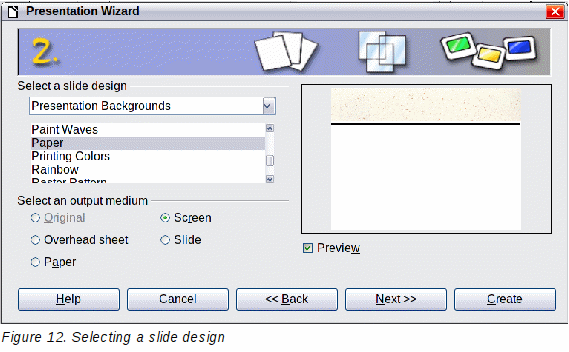
To start with a blank presentation, select <Original>. Click an item to see a preview of the slide design in the Preview window.
|
Note |
Introducing a New Product and Recommendation of a Strategy are prepackaged presentation templates. They can be used to create a presentation by choosing From template in the first step (Figure 11). |
Select how the presentation will be used under Select an output medium. Most often, presentations are created for computer screen display, so you would select Screen. You can change the page format at any time.
|
Note |
The default Screen page is optimized for a 4:3 display (28cm x 21cm) so it is not suitable for modern wide-screen displays. You can change the slide size at any time switching to Normal view and selecting Format > Page. |
Click Next. The Presentation Wizard step 3 appears.
Choose the desired slide transition from the Effect drop-down menu.
Select the desired speed for the transition between the different slides in the presentation from the Speed drop-down menu. Medium is a good choice for now.
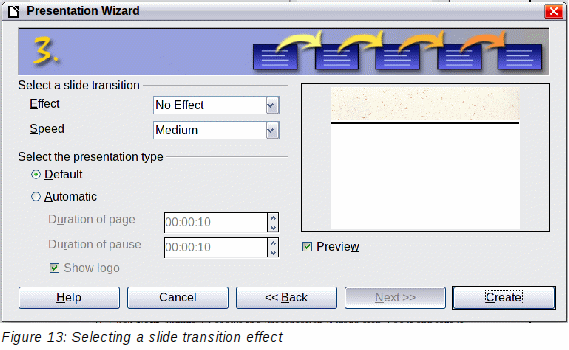
Click Create. A new presentation is created.
|
Tip |
You might want to accept the default values for both Effect and Speed unless you are skilled at creating presentations. Both of these values can be changed later while working with slide transitions and animations. These two are explained in more detail in Chapter 9. Slide Shows. |
|
Note |
If you selected From template on step 1 of the Wizard, the Next button will be active on step 3 and other pages will be available. These pages are not described here. |
|
Caution
|
Remember to save frequently while working on the presentation, to prevent any loss of information should something unexpected occur. You might also want to activate the AutoRecovery function (Tools > Options > Load/Save > General). Make sure Save AutoRecovery information every is selected and that you have entered a recovery frequency. |
A new presentation only contains one empty slide. In this section we will start adding new slides and preparing them for the intended contents.
This can be done in a variety of ways; take your pick.
Insert > Slide.
Right-click on the present slide, and select Slide > New Slide from the pop-up menu.
Click the Slide icon in the Presentation toolbar.

Sometimes, rather than starting from a new slide you want to duplicate a slide you have already inserted. To do so select the slide you want to duplicate from the Slides pane and then choose Insert > Duplicate Slide.
In the Tasks pane, select the Layout drawer to display the available layouts. The Layouts differ in the number of elements a slide will contain, from a blank slide to a slide with six contents boxes and a title.
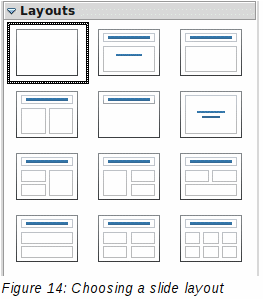
The first slide in a presentation is normally a title slide. The Title Slide (which also contains a section for a subtitle) or Title Only are suitable layouts for the first slide, while for most of the slides you will probably use the Title, Contents layout.
To create the title, click on Click to add title (assuming the Blank Slide layout was not used) and then type the title text. To adjust the formatting of the title, modify the Title presentation style; see Chapter 2, Using Slide Masters, Styles, and Templates, for instructions.
If you are using the Title Slide layout, click on Click to add text to add a subtitle. Proceed as above to make adjustments to the formatting if required modifying the Subtitle presentation style instead.
|
Tip |
To view the names for the prepackaged layouts, use the Tooltip feature: position the cursor on an icon in the Layout section (or on any toolbar icon) and its name will be displayed in a small rectangle. If tooltips are not enabled, choose Tools > Options > LibreOffice > General > Help and select the Tips option. If the Extended tips option is also selected, you will get more detailed tooltip information, but the tooltip names themselves will not be provided. |
To select or change the layout, place the slide in the work area and select the desired layout from the layout drawer in the Task Pane.
Several layouts contain one or more content boxes. Each of these boxes can be configured to contain one of the following elements: Text, Movie, Picture, Chart or Table.
You can choose the type of contents by clicking on the icon that is displayed in the middle of the contents box as shown in Figure 15. If instead you intend to use the contents box for text, just click on the “Click to add text” area to get a cursor.
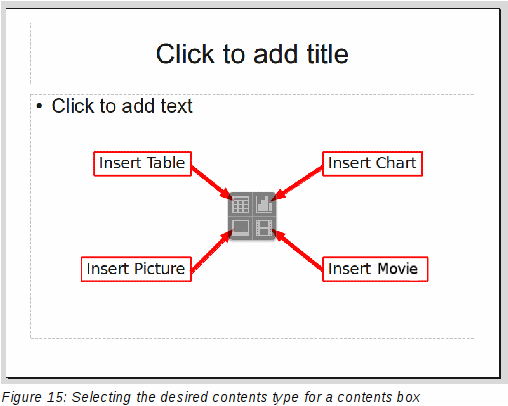
|
Note |
Text and graphic elements can be readjusted at any time during the preparation of the presentation, but changing the layout of a slide that already contains some contents can have a dramatic effect. It is therefore recommended that you pay particular attention to the layout you select. If you do need to change the layout after contents have been added, the contents are not lost though they may need to be reformatted. |
At this stage, the slide consists of everything contained in the slide master, as well as in the chosen layout slide; you may want to remove unneeded elements and add objects (such as pictures), as well as insert text.
|
Caution
|
Changes to any of the prepackaged layouts should only be made using View > Normal. Attempting to make changes by modifying a slide master may result in unpredictable results and requires extra care as well as a certain amount of trial and error. |
To add any pictures or objects to the slide. follow these steps:
To add a picture to the selected frame:
In Normal view, click on the Insert Picture icon. The Insert picture dialog box opens.
Browse to the location of the picture you want to include. To see a preview of the picture, check Preview at the bottom of the Insert picture dialog box.
Select the picture and click Open.
Resize the picture as necessary. Follow the directions in the Caution note below.
To add pictures from graphic files without utilizing the Insert Picture icon:
Insert > Picture > From File. The Insert picture dialog box opens.
Browse to the graphic file. To see a preview of the picture, check Preview at the bottom of the Insert picture dialog box. Select a picture and click Open.
Move the picture to its location.
Resize the picture, if necessary.
To add OLE Objects, refer to Chapter 7, Inserting Spreadsheets, Charts, and Other Objects, where this advanced technique is described.
|
Caution
|
When resizing a graphic, right-click the picture. Select Position and Size from the context menu and make sure that Keep ratio is selected. Then adjust the height or width to the size you need. (As you adjust one dimension both dimensions will change.) Failure to do so will cause the picture to become distorted. Remember also that resizing a bitmap image will reduce its quality on screen, even though the original image is unchanged (Impress stores the original file). A better approach is to create an image of the desired size outside of Impress and then import it into the presentation. |
To add text to a slide that contains a text frame, click on Click to add text in the text frame and then type your text. The Outline styles are automatically applied to the text as you insert it. You can change the outline level of each paragraph as well as its position within the text by using the arrow buttons on the Text Formatting toolbar (see “Outline view” on page 8).
To remove any element on the slide that is not required, click the element to select it. The green handles show that it is selected; press the Delete key to remove it.
Modifying the appearance of slides
To change the background and other characteristics of all slides in the presentation, you need to modify the slide master or choose a different slide master.
A Slide Master is a slide with a specified set of characteristics that acts as a template and is used as the starting point for creating other slides. These characteristics include the background, objects in the background, formatting of any text used, and any background graphics.
|
Note |
LibreOffice uses three interchangeable terms for this one concept. Master slide, slide master, and master page all refer to a slide that is used to create other slides. This book, however, uses only the term slide master, except when describing the user interface. |
Impress has a range of prepackaged slide masters, found in the Master Pages section of the Tasks pane. You can also create and save additional slide masters or add more from other sources. See Chapter 2 for information on creating and modifying slide masters.
If all you need to do is to change the background, you can take a shortcut:
Select Format > Page and go to the Background tab.
Select the desired background between solid color, gradient, hatching, and bitmap. Click OK to apply it.
A dialog box opens, asking if the background should be applied to all the slides. If you click Yes, Impress automatically modifies the slide master for you.
By default the slide show will display all the slides in the same order as they appear in the slide sorter, using any transition between slides specified in the Presentation Wizard, and you need some keyboard or mouse interaction to move from one slide to the next.
Now is a good time to review the entire presentation and answer some questions. Run the slide show at least once (see “Running the slide show” on page 20) before answering them. You might want to add some questions of your own.
Are the slides in the correct order? If not, some of them will need to be moved.
Is the information well spaced and visible to members of an audience at the back of a large room? They may not be able to see information at the bottom of a slide, so you may need to design your presentation to fit the top three-quarters of the screen.
Would an additional slide make a particular point clearer? If so, another slide needs to be created.
Do some of the slides seem unnecessary? Hide or delete them.
Would custom animations help some of the slides? (Advanced technique.)
Should some of the slides have a different slide transition than others? The transition of those slides should be changed.
|
Caution
|
If one or more slides seem to be unnecessary, hide the slide or slides, and view the slide show a few more times to make sure they aren't needed. To hide a slide, right-click the slide in the Slides pane and select Hide Slide in the pop-up menu. Do not delete a slide until you have done this; otherwise you may have to create that slide again. |
Once you have answered these and your own questions, make the necessary changes. This is done most easily in the Slide Sorter view (see page 11). Use the Slide Show menu to change the order of the slides, choose which ones are shown, automate moving from one slide to the next, and other settings. To change the slide transition, animate slides, and make other enhancements, use the various selections in the Task pane.
If you wish to add a custom animation to a slide, do it now. Custom animations are found in the Custom Animation section of the the Tasks pane,. This is an advanced technique and is explained in Chapter 9, Slide shows.
Your first slide show should probably have the same slide transition for all slides. Setting Advance slide to On mouse click is the default. If you want each slide to be shown for a specific amount of time, click Automatically after and enter the number of seconds. Click Apply to all slides.
Transition choices are found under Slide Transition on the Tasks pane. For more information about slide transitions, see Chapter 9, Slide Shows.
|
Tip |
The Slide transition section has a very useful option: Automatic preview. With this option selected, when you make any changes in a slide transition, the new slide is previewed in the Slide Design area, including its transition effect. |
To run the slide show, do one of the following:
Click Slide Show > Slide Show on the main menu bar.
Click the Slide Show button on the Presentation toolbar or the Slide Sorter toolbar (Figure 10).
Press F5 or F9. (F9 does not work on a Mac.)
If the slide transition is Automatically after x seconds, let the slide show run by itself.
If the slide transition is On mouse click, do one of the following to move from one slide to the next.
Click the mouse button to advance to the next slide.
Use the arrow keys on the keyboard to go to the next slide or to go back to the previous one.
Press the Spacebar on the keyboard to advance to the next slide.
Right-click anywhere on the screen to open a menu from which you can navigate the slides and set other options.
When you advance past the last slide, the message Click to exit presentation... appears. Click the mouse or press any key to exit the presentation.
To exit the slide show at any time including at the end, press the Esc key.